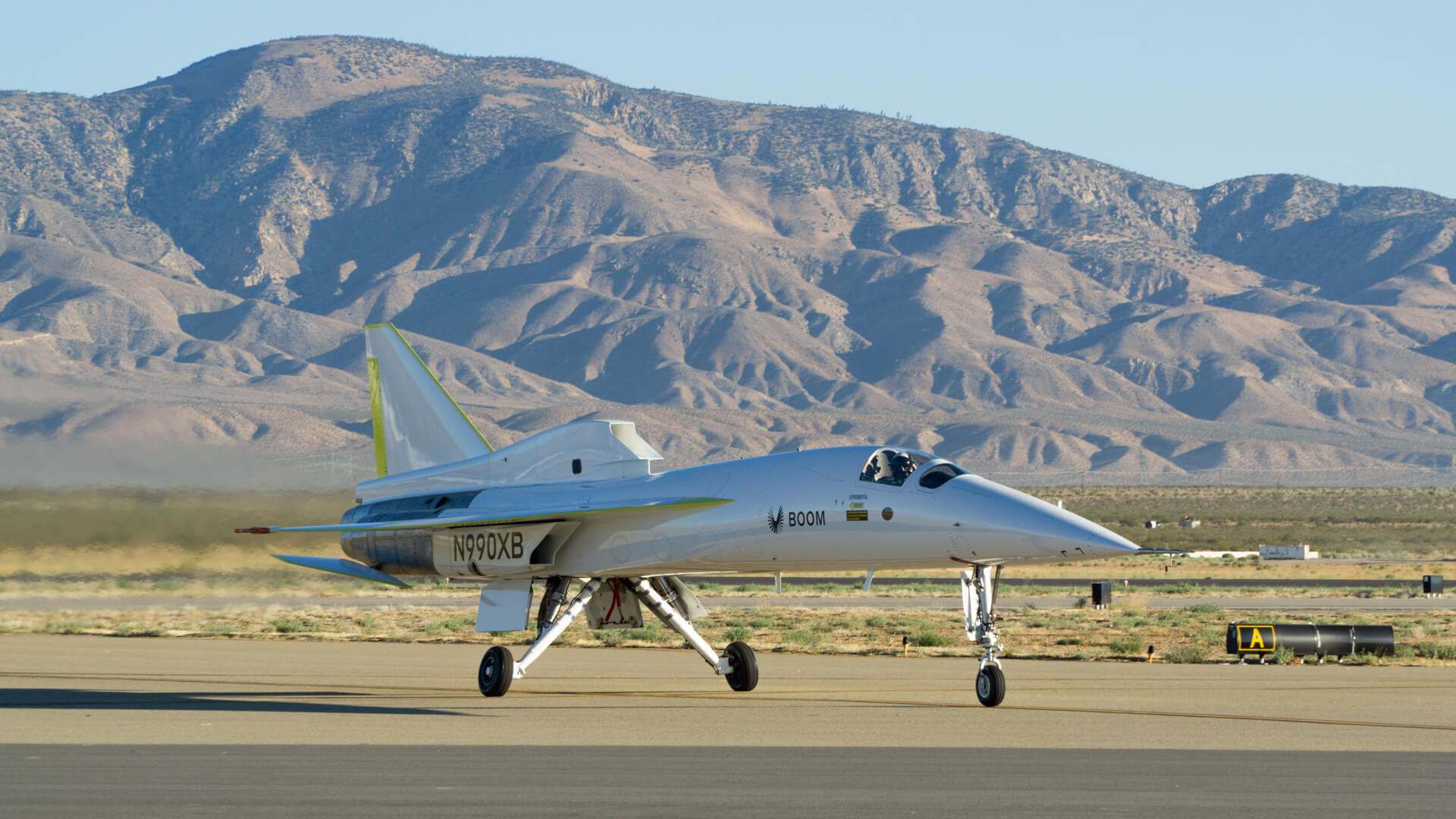Insider Brief
- Boom Supersonic’s XB-1 successfully demonstrated Boomless Cruise, a supersonic flight mode that prevents sonic booms from reaching the ground by leveraging atmospheric refraction.
- By flying at specific altitudes and speeds between Mach 1.1 and Mach 1.2, Overture will ensure its shockwaves refract harmlessly upward, unlike traditional supersonic aircraft that generate disruptive ground-level booms.
- Over water, where it cruises at Mach 1.7, Overture will generate a sonic boom because Mach cutoff conditions no longer apply, allowing the shockwave to reach the surface unimpeded.
- Image credit: Boom Supersonic
Boom Supersonic’s experimental XB-1 aircraft recently achieved supersonic flight without producing an audible sonic boom at ground level, demonstrating the feasibility of “Boomless Cruise.” The technology could allow Overture, Boom’s planned supersonic airliner, to fly at speeds up to 50% faster than conventional airliners over land while remaining within regulatory noise limits.
This development comes as Boom Supersonic aims to revive commercial supersonic travel following the Concorde’s retirement in 2003. Unlike Concorde, which generated disruptive sonic booms, Overture will use atmospheric physics to prevent the boom from reaching the ground, potentially clearing the way for supersonic flight over populated areas.

The Science Behind Boomless Cruise
We will try to break this boom in boomless cruise down a bit.
Boomless Cruise is based on a well-known aerodynamic principle called Mach cutoff — as revealed in this Penn State study and the company’s FAQs. A sonic boom occurs when an aircraft exceeds the speed of sound, creating shockwaves that propagate to the ground. However, the propagation of these shockwaves is influenced by atmospheric conditions, including temperature gradients and wind patterns, which affect the local speed of sound.
By flying at high altitudes and carefully selecting speeds between Mach 1.1 and Mach 1.2, Overture’s sonic boom will refract upwards, dissipating into the upper atmosphere instead of reaching the ground. If you ever noticed how light bends when it passes through water, you’ll have a good idea of this effect.
Unlike low-boom designs, which require extensive aircraft shaping to minimize boom intensity, Boomless Cruise relies primarily on altitude, speed and real-time atmospheric adjustments, the company reports. Overture’s advanced autopilot system will optimize its cruising speed to maintain Mach cutoff conditions dynamically.
Design Features Enabling Boomless Cruise
Overture’s Symphony engines play a critical role in enabling Boomless Cruise. These engines, developed specifically for supersonic flight, feature enhanced transonic performance, allowing the aircraft to efficiently accelerate past Mach 1 at high altitudes.
The aircraft’s autopilot system continuously monitors atmospheric conditions, adjusting speed in real time to ensure the boom remains above the ground. This is a departure from previous supersonic airliners, which operated at fixed speeds regardless of environmental factors.
Although Overture is designed to operate in Boomless Cruise mode over land, it will still generate a sonic boom when flying at its full speed of Mach 1.7 over water.
Speed and Efficiency Considerations
Boom Supersonic estimates that Boomless Cruise will allow flights to be 40-50% faster than conventional airliners. A New York to Los Angeles flight, for example, could be up to 90 minutes shorter. Long-haul routes with mixed overland and overwater segments, such as Chicago to Frankfurt, will see incremental time savings.
Fuel efficiency remains a tradeoff. While Overture is optimized for cruising at Mach 0.94 and Mach 1.7, flying at low supersonic speeds (Mach 1.1 to 1.2) incurs a modest drag penalty, increasing fuel consumption. However, Boom Supersonic indicates that Overture will still have sufficient range for long-haul routes, such as Vancouver to Miami.
Regulatory Hurdles
Currently, U.S. Federal Aviation Administration (FAA) regulations prohibit all supersonic flight over land under 14 CFR 91.817, regardless of whether a sonic boom reaches the ground. Boom Supersonic has advocated for revising these regulations to allow Boomless Cruise, arguing that it would promote innovation and strengthen U.S. aviation leadership.
While Overture’s initial design is not intended for unrestricted supersonic flight over land, regulatory changes could pave the way for future commercial applications. Boom Supersonic’s work with the U.S. Air Force and defense contractors, including Northrop Grumman, suggests that military and government applications could be early adopters of Boomless Cruise technology.
The Future of Supersonic Travel
Boom Supersonic’s Overture airliner, designed to run on 100% sustainable aviation fuel, has already secured 130 orders and pre-orders from airlines including American Airlines, United Airlines, and Japan Airlines. The company’s XB-1 demonstrator, which first flew in March 2024, is expected to validate key technologies ahead of Overture’s planned service entry.
Read more about Boomless Cruise here.
Share this article:











